Switch and Swim Surf Zone Landing
by Wayne Horodowich
There may come a time when someone in your group will not feel comfortable to land their kayak through the surf zone. Why they are in that situation in the first place is another discussion. You need to get the timid paddler and their kayak to shore, but the timid paddler doesn't want to paddle through the surf zone. When faced with that situation I came up with the "Switch & Swim Surf Zone Landing." The concept is simple, but it takes work. You and the timid paddler need to feel comfortable swimming through a surf zone. You would use a paddler who is confident in landing boats through surf to swim out to land the boat belonging to the timid paddler. Then the timid paddler could swim in through the surf. While paddling with groups in Hawaii I have had to use the "Switch & Swim" technique to get some of the boats ashore in large shore breaks. The paddlers didn't mind swimming in through the waves, but they didn't want to be anywhere near the boats in the shore break.
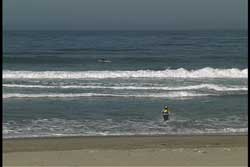 Once you have established that a group member does not want to land through the surf then you need to make a plan. If you have the luxury of extra group members one of the group should stay out in the staging area until the switch occurs. In this example I am assuming it is only me and the timid paddler. Before I land, my partner and I discuss the plan and establish that the timid partner will be capable of swimming to shore through the surf. If I cannot fit into my partner's kayak then this technique will not work. After the plan is decided, I paddle to shore while my partner waits for me in the staging area. As a side note, if I cannot fit in the other kayak I just push it ashore through the surf.
Once you have established that a group member does not want to land through the surf then you need to make a plan. If you have the luxury of extra group members one of the group should stay out in the staging area until the switch occurs. In this example I am assuming it is only me and the timid paddler. Before I land, my partner and I discuss the plan and establish that the timid partner will be capable of swimming to shore through the surf. If I cannot fit into my partner's kayak then this technique will not work. After the plan is decided, I paddle to shore while my partner waits for me in the staging area. As a side note, if I cannot fit in the other kayak I just push it ashore through the surf.
After I land my kayak, I decide what clothing I plan to wear to swim out to my partner who is waiting in the staging area. This next statement is going to get criticism, but it needs to be considered. Under normal surf conditions I would wear my PFD. However, there have been times when I decided not to wear my PFD, because it gave me too much buoyancy with the wetsuit I was already wearing. In Hawaii with the big shore breaks, I had to get as close to the bottom when swimming under the waves so I only had my bathing suit on. I also had a pair of body surfing fins to get me through the surf by going under it. If you choose to not wear a PFD you need to weigh all the risks and benefits in doing so. It is not a decision that is made lightly. If something goes wrong you will be without your PFD. There are times when going under the waves may be your only option. Once I have decided what to wear, I swim out to my partner who is waiting in their kayak in the staging area. The staging area is out past the surf zone where the swells just roll under the waiting kayak.
 When I get through the surf zone I meet up with my partner. This could be a good time to get a short distance transfer (bow push) to deeper water where the switch will occur. See USK article, "Swimmer Assists". It is prudent to be a little farther out from the break zone than you think, because there are some sneaker waves that sometimes come in. You don't want to be switching positions and get surfed in at the same time.
When I get through the surf zone I meet up with my partner. This could be a good time to get a short distance transfer (bow push) to deeper water where the switch will occur. See USK article, "Swimmer Assists". It is prudent to be a little farther out from the break zone than you think, because there are some sneaker waves that sometimes come in. You don't want to be switching positions and get surfed in at the same time.
You also need to consider issues regarding the spray skirt. If your skirt doesn't fit the second kayak's coaming then it is useless. Can you fit into the skirt your partner has for their kayak? When does the timid paddler take off their skirt and when do you put it on? If the skirt has shoulder straps then you may have to remove paddle jackets &/or PFD's. If the skirt has a large enough tunnel, so it can fit over both paddlers head and shoulders, then the switch can be made while either is sitting in the cockpit. Otherwise it may have to be done in the water pulling it over your legs.
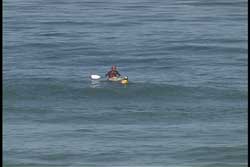 When ready to make the switch I stabilize the timid paddlers kayak while I am in the water. There a a number of ways to do this so choose the one that works best for you. This is a good skill to practice with your partners when you have your capsize recovery practice days. I like being near the bow so I can watch the paddler get out of their kayak. I find a spot where one arm can reach under the kayak and grab the opposite deck line. The other arm reaches straight up to hold the deck line on the same side as my head. I get as close to the cockpit as my reach allows while keeping my head comfortably above water. This allows me to provide stability in either direction. Being able to see the paddler get out of their kayak allows me to anticipate which way they may be leaning so I can compensate accordingly. It is best if the paddler getting out of the kayak does it quickly as possible. Our goal is to not get water into the cockpit so we will not have to deal with draining water. This is another good skill to practice during those wet training days. Two paddlers trying to empty water from a swamped kayak while both are in the water.
When ready to make the switch I stabilize the timid paddlers kayak while I am in the water. There a a number of ways to do this so choose the one that works best for you. This is a good skill to practice with your partners when you have your capsize recovery practice days. I like being near the bow so I can watch the paddler get out of their kayak. I find a spot where one arm can reach under the kayak and grab the opposite deck line. The other arm reaches straight up to hold the deck line on the same side as my head. I get as close to the cockpit as my reach allows while keeping my head comfortably above water. This allows me to provide stability in either direction. Being able to see the paddler get out of their kayak allows me to anticipate which way they may be leaning so I can compensate accordingly. It is best if the paddler getting out of the kayak does it quickly as possible. Our goal is to not get water into the cockpit so we will not have to deal with draining water. This is another good skill to practice during those wet training days. Two paddlers trying to empty water from a swamped kayak while both are in the water.
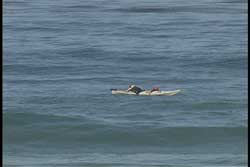 When the timid paddler is in the water he or she stabilizes the kayak so I can climb into their kayak without capsizing. In this case the timid paddler chooses to stabilize the kayak by being on the opposite side of me when I climb on. They use their body weight to counteract the forces I generate. Once I am in the kayak with my spray skirt attached, we can deal with getting the swimmer back to shore.
When the timid paddler is in the water he or she stabilizes the kayak so I can climb into their kayak without capsizing. In this case the timid paddler chooses to stabilize the kayak by being on the opposite side of me when I climb on. They use their body weight to counteract the forces I generate. Once I am in the kayak with my spray skirt attached, we can deal with getting the swimmer back to shore.
There are different philosophies about helping the swimmer through the surf. My personal opinion is not to have the kayak anywhere near the swimmer as they are in the surf zone. Once a sea kayak is in the surf zone you are mostly at the mercy of the surf. When I am in a kayak in the surf zone I don't want to run over any swimmer and I don't want them smashing into me or my kayak. I also don't want the resistance they will add if they are holding onto my kayak. I feel I can do the most good by landing first and then swimming out into the surf to help them if they need assistance. In fact, it could be a great time to use a paddle swim to get the two of you to shore. See USK article, "Paddle Swim". If the timid paddler is capable of getting in through the surf on their own and they want to do a paddle swim they could take the spare paddle (which you should have with you on the trip) and use it to get to shore. This will work if you left the spare paddle with the timid paddler when the first kayak landed. If you didn't bring a spare paddle (tempting the wrath of Neptune) then you will need to swim out with your paddle if the timid paddler needs their paddle to swim ashore.
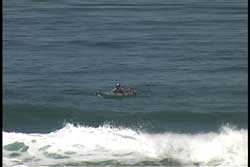 If you remember, earlier we used a bow push to move the swimmer to deeper water where the switch occurred. Now it is time to move back to the staging area. This time we have the swimmer holding the back of the kayak as the paddler heads toward shore. The reason it is best to have the paddler behind the kayak is in case you misjudge the waves and the kayak gets taken by a steepening wave. If that is the case, then the swimmer can let go and the kayak will be taken away from them. If you severely misjudge and a breaking wave is on you, then the swimmer can push the kayak forward and move to the side while the paddler sprints forward. Your greatest concern is getting distance between the swimmer and the kayak. This latter example should never occur, because it is your responsibility to be scanning the ocean behind you at all times. If you time it properly, you can tow the swimmer close to the break zone where they let go of the kayak and then the paddler continues into shore putting distance between the swimmer and the kayak.
If you remember, earlier we used a bow push to move the swimmer to deeper water where the switch occurred. Now it is time to move back to the staging area. This time we have the swimmer holding the back of the kayak as the paddler heads toward shore. The reason it is best to have the paddler behind the kayak is in case you misjudge the waves and the kayak gets taken by a steepening wave. If that is the case, then the swimmer can let go and the kayak will be taken away from them. If you severely misjudge and a breaking wave is on you, then the swimmer can push the kayak forward and move to the side while the paddler sprints forward. Your greatest concern is getting distance between the swimmer and the kayak. This latter example should never occur, because it is your responsibility to be scanning the ocean behind you at all times. If you time it properly, you can tow the swimmer close to the break zone where they let go of the kayak and then the paddler continues into shore putting distance between the swimmer and the kayak.
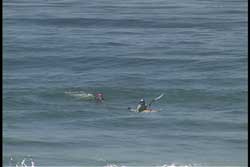 After I separate from the swimmer I head into shore and land as quickly as possible. As I land I keep an eye on the waves and the swimmer. Once I am in the surf zone there is not much I can do for the swimmer, but I want to know where they are. After landing and moving the kayak above the high water line, I head back down to the beach to watch and or help the swimmer coming in. I like to keep an eye on their location in case I need to get to them. You may loose sight of them as waves come in or as they go under the waves, but you will see them again after the wave passes. There have been some times I have gone out to meet them in the zone and we swam in together. If the timid paddler wanted my company through the entire surf zone, they would have to wait in the staging area until I landed and swam out to meet them.
After I separate from the swimmer I head into shore and land as quickly as possible. As I land I keep an eye on the waves and the swimmer. Once I am in the surf zone there is not much I can do for the swimmer, but I want to know where they are. After landing and moving the kayak above the high water line, I head back down to the beach to watch and or help the swimmer coming in. I like to keep an eye on their location in case I need to get to them. You may loose sight of them as waves come in or as they go under the waves, but you will see them again after the wave passes. There have been some times I have gone out to meet them in the zone and we swam in together. If the timid paddler wanted my company through the entire surf zone, they would have to wait in the staging area until I landed and swam out to meet them.
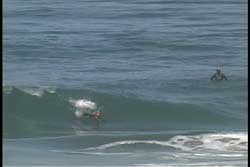 If you are going to be launching and landing in surf I feel it is important to get comfortable in that environment. The only true way to gain comfort is to understand the forces in that environment. Therefore, I recommend playing in the surf even before you learn to kayak in it. See USK article, "Tuning & Timing." Most of the time I will go out and body surf after the group has landed if there are decent waves. I enjoy playing in the waves and feeling the forces in the water. Body surfing, in through the surf, can be your fastest way to shore when you are swimming through the surf zone. In addition, the timing and take off points you learn while body surfing translates beautifully to surfing your kayak.
If you are going to be launching and landing in surf I feel it is important to get comfortable in that environment. The only true way to gain comfort is to understand the forces in that environment. Therefore, I recommend playing in the surf even before you learn to kayak in it. See USK article, "Tuning & Timing." Most of the time I will go out and body surf after the group has landed if there are decent waves. I enjoy playing in the waves and feeling the forces in the water. Body surfing, in through the surf, can be your fastest way to shore when you are swimming through the surf zone. In addition, the timing and take off points you learn while body surfing translates beautifully to surfing your kayak.
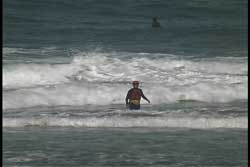 If your plan is well thought out and the skills of the paddlers meet the challenges, then the timid paddler will find him or herself coming ashore with their group and kayak waiting for them. As I mentioned earlier, if there are more than two in the group then after the timid paddler gets to shore the kayaker that waited with them at the staging area can now land. If you had that third boater they could have been instrumental in stabilizing the kayak while the two other paddlers switched positions. Think about how to best utilize the group in these unique situations.
If your plan is well thought out and the skills of the paddlers meet the challenges, then the timid paddler will find him or herself coming ashore with their group and kayak waiting for them. As I mentioned earlier, if there are more than two in the group then after the timid paddler gets to shore the kayaker that waited with them at the staging area can now land. If you had that third boater they could have been instrumental in stabilizing the kayak while the two other paddlers switched positions. Think about how to best utilize the group in these unique situations.
I am sure you realize by now that these paddlers will be spending some significant time in the water. If the first swimmer had to swim out, land and then swim out to help the timid paddler through the surf, their exposure time will be considerable. Therefore, dressing for exposure is vital for this technique to work. When I am in Hawaii exposure is not a consideration except for sunburn (UV rays).
I am not going to tell you that this technique will work in all surf zones. If you have a significant long shore current then you have other challenges. If the surf is huge then I would not recommend this as an option. Big surf provides additional challenges and risks. It is difficult to swim in the aerated whitewater. I once went out to body surf in big Hawaiian waves. I was feeling brave and wanted to give it a try (NOT one of my smarter moments). When I got halfway out I knew I was in trouble. I was surrounded by whitewater and waves were continuing to roll over me. I knew I needed to get to shore or blue water. Blue water was closer so I took the best breath I could and went down. I swam out as far as my lungs could take it. I came up ready to take a quick breath (if I could) and go back down. I was glad I made it out to blue water. The only reason I made it was because I had body surfing fins on. Now I had to think about getting back in. When the right wave came in I rode it toward shore. When it broke I knew I was going to ride it all the way in while holding my breath. It was a great ride and a very long breath hold, but I learned a valuable lesson that day about big surf and the aerated whitewater in big surf. The length of the surf zone also needs to be considered along with the wave size and frequency. How much energy will it take and how long will it take to get out to your partner? As you can see, there are a number of factors that need to be addressed before you jump in and swim out.
Landing a partner's kayak can be for a number of reasons other than feeling timid about landing in surf. If you have a very seasick paddler this may be the option you choose for getting the sick paddler ashore. Of course you can always just have the paddler in question paddle toward shore and bail out of their kayak when confronted by the waves and let the waves take their kayak to shore. I am not a big fan of letting waves tumble kayaks in the surf zone if I can find ways to prevent it. I once had to land a boat for someone in the group, because there was a rocky beach and they trusted my surfing skills more than their own. They had a new composite boat and they didn't want to smash it up. Thank goodness I was able to fit in the kayak. It gave me the opportunity to smash it up :-). If you do this for another paddler, discuss in advance that you will do the best you can, but you are not responsible for damages to their kayak.
As always, I recommend that you practice this technique in advance of needing it. Start in a small surf zone to work out the orchestration of your plan. Once you feel comfortable with the skill you can add it to your bag of tricks. The need to use it doesn't come up often. However, if it does, you will be glad you have it as an option.
Pictures seen above were taken from the Award Winning USK Video "ABC'S
of the Surf Zone"
USK Home
Page
© Copyright USK
 Once you have established that a group member does not want to land through the surf then you need to make a plan. If you have the luxury of extra group members one of the group should stay out in the staging area until the switch occurs. In this example I am assuming it is only me and the timid paddler. Before I land, my partner and I discuss the plan and establish that the timid partner will be capable of swimming to shore through the surf. If I cannot fit into my partner's kayak then this technique will not work. After the plan is decided, I paddle to shore while my partner waits for me in the staging area. As a side note, if I cannot fit in the other kayak I just push it ashore through the surf.
Once you have established that a group member does not want to land through the surf then you need to make a plan. If you have the luxury of extra group members one of the group should stay out in the staging area until the switch occurs. In this example I am assuming it is only me and the timid paddler. Before I land, my partner and I discuss the plan and establish that the timid partner will be capable of swimming to shore through the surf. If I cannot fit into my partner's kayak then this technique will not work. After the plan is decided, I paddle to shore while my partner waits for me in the staging area. As a side note, if I cannot fit in the other kayak I just push it ashore through the surf.  When I get through the surf zone I meet up with my partner. This could be a good time to get a short distance transfer (bow push) to deeper water where the switch will occur. See USK article,
When I get through the surf zone I meet up with my partner. This could be a good time to get a short distance transfer (bow push) to deeper water where the switch will occur. See USK article,  When ready to make the switch I stabilize the timid paddlers kayak while I am in the water. There a a number of ways to do this so choose the one that works best for you. This is a good skill to practice with your partners when you have your capsize recovery practice days. I like being near the bow so I can watch the paddler get out of their kayak. I find a spot where one arm can reach under the kayak and grab the opposite deck line. The other arm reaches straight up to hold the deck line on the same side as my head. I get as close to the cockpit as my reach allows while keeping my head comfortably above water. This allows me to provide stability in either direction. Being able to see the paddler get out of their kayak allows me to anticipate which way they may be leaning so I can compensate accordingly. It is best if the paddler getting out of the kayak does it quickly as possible. Our goal is to not get water into the cockpit so we will not have to deal with draining water. This is another good skill to practice during those wet training days. Two paddlers trying to empty water from a swamped kayak while both are in the water.
When ready to make the switch I stabilize the timid paddlers kayak while I am in the water. There a a number of ways to do this so choose the one that works best for you. This is a good skill to practice with your partners when you have your capsize recovery practice days. I like being near the bow so I can watch the paddler get out of their kayak. I find a spot where one arm can reach under the kayak and grab the opposite deck line. The other arm reaches straight up to hold the deck line on the same side as my head. I get as close to the cockpit as my reach allows while keeping my head comfortably above water. This allows me to provide stability in either direction. Being able to see the paddler get out of their kayak allows me to anticipate which way they may be leaning so I can compensate accordingly. It is best if the paddler getting out of the kayak does it quickly as possible. Our goal is to not get water into the cockpit so we will not have to deal with draining water. This is another good skill to practice during those wet training days. Two paddlers trying to empty water from a swamped kayak while both are in the water.  When the timid paddler is in the water he or she stabilizes the kayak so I can climb into their kayak without capsizing. In this case the timid paddler chooses to stabilize the kayak by being on the opposite side of me when I climb on. They use their body weight to counteract the forces I generate. Once I am in the kayak with my spray skirt attached, we can deal with getting the swimmer back to shore.
When the timid paddler is in the water he or she stabilizes the kayak so I can climb into their kayak without capsizing. In this case the timid paddler chooses to stabilize the kayak by being on the opposite side of me when I climb on. They use their body weight to counteract the forces I generate. Once I am in the kayak with my spray skirt attached, we can deal with getting the swimmer back to shore.  If you remember, earlier we used a bow push to move the swimmer to deeper water where the switch occurred. Now it is time to move back to the staging area. This time we have the swimmer holding the back of the kayak as the paddler heads toward shore. The reason it is best to have the paddler behind the kayak is in case you misjudge the waves and the kayak gets taken by a steepening wave. If that is the case, then the swimmer can let go and the kayak will be taken away from them. If you severely misjudge and a breaking wave is on you, then the swimmer can push the kayak forward and move to the side while the paddler sprints forward. Your greatest concern is getting distance between the swimmer and the kayak. This latter example should never occur, because it is your responsibility to be scanning the ocean behind you at all times. If you time it properly, you can tow the swimmer close to the break zone where they let go of the kayak and then the paddler continues into shore putting distance between the swimmer and the kayak.
If you remember, earlier we used a bow push to move the swimmer to deeper water where the switch occurred. Now it is time to move back to the staging area. This time we have the swimmer holding the back of the kayak as the paddler heads toward shore. The reason it is best to have the paddler behind the kayak is in case you misjudge the waves and the kayak gets taken by a steepening wave. If that is the case, then the swimmer can let go and the kayak will be taken away from them. If you severely misjudge and a breaking wave is on you, then the swimmer can push the kayak forward and move to the side while the paddler sprints forward. Your greatest concern is getting distance between the swimmer and the kayak. This latter example should never occur, because it is your responsibility to be scanning the ocean behind you at all times. If you time it properly, you can tow the swimmer close to the break zone where they let go of the kayak and then the paddler continues into shore putting distance between the swimmer and the kayak. After I separate from the swimmer I head into shore and land as quickly as possible. As I land I keep an eye on the waves and the swimmer. Once I am in the surf zone there is not much I can do for the swimmer, but I want to know where they are. After landing and moving the kayak above the high water line, I head back down to the beach to watch and or help the swimmer coming in. I like to keep an eye on their location in case I need to get to them. You may loose sight of them as waves come in or as they go under the waves, but you will see them again after the wave passes. There have been some times I have gone out to meet them in the zone and we swam in together. If the timid paddler wanted my company through the entire surf zone, they would have to wait in the staging area until I landed and swam out to meet them.
After I separate from the swimmer I head into shore and land as quickly as possible. As I land I keep an eye on the waves and the swimmer. Once I am in the surf zone there is not much I can do for the swimmer, but I want to know where they are. After landing and moving the kayak above the high water line, I head back down to the beach to watch and or help the swimmer coming in. I like to keep an eye on their location in case I need to get to them. You may loose sight of them as waves come in or as they go under the waves, but you will see them again after the wave passes. There have been some times I have gone out to meet them in the zone and we swam in together. If the timid paddler wanted my company through the entire surf zone, they would have to wait in the staging area until I landed and swam out to meet them. If you are going to be launching and landing in surf I feel it is important to get comfortable in that environment. The only true way to gain comfort is to understand the forces in that environment. Therefore, I recommend playing in the surf even before you learn to kayak in it. See USK article,
If you are going to be launching and landing in surf I feel it is important to get comfortable in that environment. The only true way to gain comfort is to understand the forces in that environment. Therefore, I recommend playing in the surf even before you learn to kayak in it. See USK article,  If your plan is well thought out and the skills of the paddlers meet the challenges, then the timid paddler will find him or herself coming ashore with their group and kayak waiting for them. As I mentioned earlier, if there are more than two in the group then after the timid paddler gets to shore the kayaker that waited with them at the staging area can now land. If you had that third boater they could have been instrumental in stabilizing the kayak while the two other paddlers switched positions. Think about how to best utilize the group in these unique situations.
If your plan is well thought out and the skills of the paddlers meet the challenges, then the timid paddler will find him or herself coming ashore with their group and kayak waiting for them. As I mentioned earlier, if there are more than two in the group then after the timid paddler gets to shore the kayaker that waited with them at the staging area can now land. If you had that third boater they could have been instrumental in stabilizing the kayak while the two other paddlers switched positions. Think about how to best utilize the group in these unique situations.